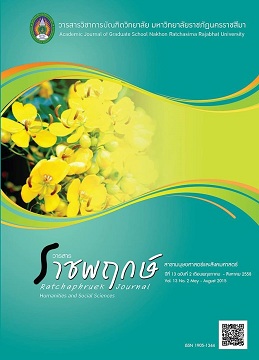เลี้ยงผีมอญ ในมิติทางคติชนวิทยา
Main Article Content
Abstract
บทความนี้เป็นส่วนหนึ่งของวิทยานิพนธ์เรื่อง เลี้ยงผีมอญบ้านพุดซา ในมิติทางคติชนวิทยา สาขาศิลปศาสตรดุษฎีบัณฑิต คณะมนุษยศาสตร์ มหาวิทยาลัยนเรศวร ผู้วิจัยมีวัตถุประสงค์เพื่อศึกษาการเลี้ยงผีมอญ บ้านพุดซา อำเภอเมือง นครราชสีมา จังหวัดนครราชสีมา ในมิติทางคติชนวิทยา โดยใช้กรอบแนวคิดการศึกษาทางคติชนวิทยา ใน 3 มิติ คือ 1) มิติแห่งปัจเจกบุคคล 2) มิติแห่งสังคมและวัฒนธรรม และ 3) มิติแห่งเทพปกรณัม/มิติเหนือโลก
ผลการศึกษาพบว่า การเลี้ยงผีมอญบ้านพุดซาในมิติแห่งปัจเจกบุคคล ได้สะท้อนพลังอำนาจของคติความเชื่อเรื่องผีบรรพบุรุษในตัวบุคคลที่เกิดและอาศัยอยู่ภายในบ้านพุดซา ที่เป็นตัวขับเคลื่อน และกลไกที่ก่อให้เกิดกระบวนการของการเลี้ยงผีมอญที่เกิดขึ้นจากคติความเชื่อส่วนบุคคล อันมีผลมาจากประสบการณ์ตรง และการถ่ายทอดทางการเห็น และการมีส่วนร่วมทั้งโดยทางตรงและทางอ้อมอย่างหลีกเลี่ยงไม่ได้ ในฐานะที่บุคคลดังกล่าวเป็นหนึ่งในสมาชิกของครอบครัวส่วนในด้านมิติแห่งสังคมและวัฒนธรรม การเลี้ยงผีมอญนอกจากจะเป็นงานที่จัดขึ้นโดยมีวัตถุประสงค์เป็นการแก้บนเพื่อให้ผู้ป่วยหายจากอาการเจ็บป่วยแล้วนั้น ยังสะท้อนให้เห็นแนวคิดที่สร้างพฤติกรรมให้แก่มนุษย์ในเรื่องการอยู่ร่วมกันของคนในสังคม ได้แก่ การที่ต้องแจกจ่ายข้าวปลาอาหารและสิ่งของต่างๆ ที่ใช้ในการเลี้ยงผีมอญ ให้แก่ญาติพี่น้องและเพื่อนบ้าน รวมถึงคนอื่นๆ ที่มาร่วมงานทุกคนให้หมด ห้ามเหลือหรือเก็บไว้ภายในบ้าน สิ่งเหล่านี้เห็นได้ชัดว่า การเลี้ยงผีมอญเป็นพิธีกรรมที่นอกจากจะให้ลูกหลานได้มีโอกาสได้เลี้ยงผีปู่ย่าตายายและบรรพบุรุษทุกคนที่เสียชีวิตไปแล้วยังเป็นการสร้างโอกาสในการทำบุญ เป็นการปลูกฝังให้ลูกหลานไม่เป็นคนเห็นแก่ตัวเห็นแก่ได้ ปลูกฝังให้เป็นผู้มีจิตใจเอื้อเฟื้อเผื่อแผ่ต่อญาติพี่น้องและคนอื่นๆ ในสังคมอีกทางหนึ่ง และท้ายสุด มิติแห่งเทพปกรณัม/มิติเหนือโลก ในการเลี้ยงผีมอญบ้านพุดซา พบว่า การเลี้ยงผีมอญบ้านพุดซา ปรากฏคติความเชื่อเรื่องโลกและสภาวะเหนือโลก หรือมิติที่สามอย่างชัดเจน โดยเฉพาะการเชื่อมโยงระหว่างโลกมนุษย์กับโลกของวิญญาณ จะเห็นได้จากการโยงผ้าอันแสดงให้เห็นถึงเส้นทางการติดต่อสื่อสาร การเดินทางไป-กลับระหว่างสองภพ ได้แก่ภพที่อยู่เบื้องบน/หรือสวรรค์กับภพภูมิที่อยู่ด้านล่างคือ โลก ทั้งนี้ ผ้าโยงในพิธีกรรมเลี้ยงผีมอญบ้านพุดซา ยังสื่อให้เห็นถึงลักษณะความเชื่อบางอย่างในศาสนาหรือลัทธิ ที่เป็นสากลคือ ลักษณะของอาร์คีไทพ์ (Archetypes) ต้นแบบอันเกี่ยวข้องกับเรื่องสภาวะตรงกันข้ามหรือทวิภาวะนั่นเอง
Leing Phe Mon in Folklore Dimensions
This article was a part of dissertation entitled “Liang Phi Mon in Folklore Dimensions” in the field of Doctorate Arts, Faculty of Humanity, Naresuan University. The researcher aimed to study how to preserve Phi Mon in Folklore Dimensions, Ban Phutsa, Amphoe Muang Nakhon Ratchasima, Nakhon Ratchasima Province by applying three dimensions of folklore dimension. They were (1) Private dimension, (2) Cultural society dimension, and (3) Pakaranum God dimension (dimensional mythology) or over the world dimension. Data from the field trip and analysis based on the framework were found that Liang Phi Mon in private dimension reflected the power of concepts on ancestor beliefs of people who were born and lived at Ban Phutsa. They were propellers and mechanism that caused the process of Liang Phi Mon from personal beliefs which happened from direct experience, besides direct and indirect participation as one part of the family. According to the social and cultural dimension, Liang Phi Mon was not only a ceremony with a purpose of making a votive offering for recovering from sickness, but reflecting the idea of humans to live together in the society also. This ceremony clearly showed that Liang Phi Mon was a ceremony of descendants to offer food to their ancestors. It was also a chance to make merits and cultivate the descendants to be free from selfishness.
In contrast, this ceremony cultivated those who attended to be friendly to the others in the society. To sum up, Pakaranum God dimension (dimensional mythology) / Super Natural for Liang Phi Mon showed the beliefs in state or the third dimension especially the connection between the world of human and soul. Tying the cloth showed the process of communication, souls travelling between two worlds, which was, the higher world or heaven and the lower or human world. Moreover, the tied cloth of Liang Phi Mon at Ban Phutsa conveyed religious beliefs or international creed of archetypes which were considered as an original type of the opposite or duality.


